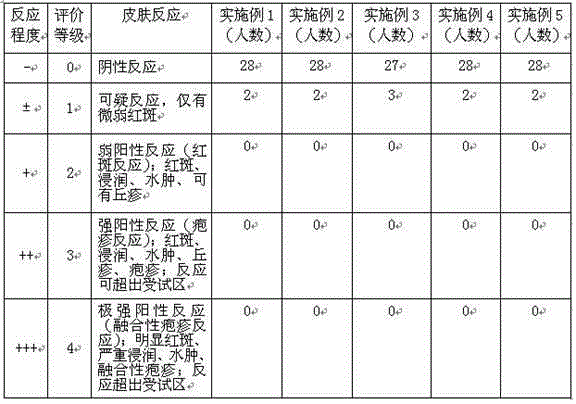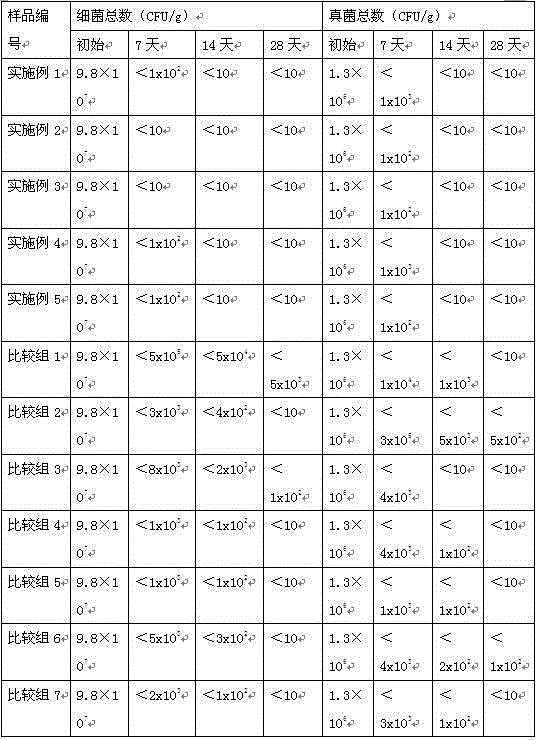Plant cosmetic preservative composition and preparation method thereof
A plant-derived, cosmetic technology, applied in the field of plant-derived cosmetic antiseptic composition and its preparation, can solve the problems of reduced product stability, high dosage, and difficulty in achieving satisfactory results, so as to reduce skin irritation, overcome excessive color, The effect of promoting antiseptic efficacy
- Summary
- Abstract
- Description
- Claims
- Application Information
AI Technical Summary
Problems solved by technology
Method used
Image
Examples
Embodiment 1
[0049] A preparation method of a plant-derived cosmetic antiseptic composition, said method comprising the following steps:
[0050] 1) Weigh 50g raspberry fruit extract and 50g Sophora japonica extract according to the mass ratio of 1:1, mix the dry powder evenly, and use it as a synergist item, as phase A;
[0051] 2) Weigh 300g grapefruit seed extract, 100g oregano whole herb extract, 100g Magnolia officinalis bark extract according to the mass ratio of 3:1:1, stir evenly, and use it as phase B;
[0052] 3) Weigh 17.24g mannose erythritol ester, 3.45g subtilisin sodium, 10.34g hydrogenated lysolecithin, 69.0g glycerin according to the mass ratio of 5:1:3:20, heat to 70°C and stir evenly, as phase C;
[0053] 4) Weigh 100g of phase A, 500g of phase B, and 100g of phase C according to the mass ratio of 1:5:1, mix phase A, phase B, and phase C, use an IKA stirrer at 1200rpm, keep at 70°C, stir for 30 minutes until uniform, and use it as D Mutually;
[0054] 5) Preheat the d...
Embodiment 2
[0057] A preparation method of a plant-derived cosmetic antiseptic composition, said method comprising the following steps:
[0058] 1) Weigh 150g raspberry fruit extract and 50g Sophora japonica extract according to the mass ratio of 3:1, mix the dry powder evenly, and use it as a synergist item, as phase A;
[0059] 2) Weigh 300g grapefruit seed extract, 200g oregano whole herb extract, 200g Magnolia officinalis bark extract according to the mass ratio of 3:2:2, stir well, and use it as phase B;
[0060] 3) Weigh 17.24g mannose erythritol ester, 3.45g subtilisin sodium, 10.34g hydrogenated lysolecithin, 69.0g glycerin according to the mass ratio of 5:3:3:20, heat to 70-75°C and stir Uniform, as phase C;
[0061] 4) Weigh 200g of phase A, 700g of phase B, and 100g of phase C according to the mass ratio of 2:7:1, mix phase A, phase B, and phase C, use an IKA stirrer at 1200rpm, keep at 75°C, stir for 30 minutes until uniform, and use it as D Mutually;
[0062] 5) Preheat th...
Embodiment 3
[0065] A preparation method of a plant-derived cosmetic antiseptic composition, said method comprising the following steps:
[0066] 1) Weigh 240g raspberry fruit extract and 60g Sophora japonica extract according to the mass ratio of 4:1, mix the dry powder evenly, and use it as a synergist item, as phase A;
[0067] 2) Weigh 250g grapefruit seed extract, 150g oregano whole herb extract, 100g Magnolia officinalis bark extract according to the mass ratio of 5:3:2, stir well, and use it as phase B;
[0068] 3) Weigh 35.56g mannose erythritol ester, 8.89g subtilisin sodium, 22.22g hydrogenated lysolecithin, 133.33g glycerin according to the mass ratio of 8:2:5:30, heat to 70-75°C and stir Uniform, as phase C;
[0069] 4) Weigh 300g of Phase A, 500g of Phase B, and 200g of Phase C according to the mass ratio of 3:5:2, mix Phase A, Phase B, and Phase C, use an IKA stirrer at 1200rpm, keep at 75°C, stir for 30 minutes until uniform, and use it as D Mutually;
[0070] 5) Preheat ...
PUM
 Login to View More
Login to View More Abstract
Description
Claims
Application Information
 Login to View More
Login to View More - R&D
- Intellectual Property
- Life Sciences
- Materials
- Tech Scout
- Unparalleled Data Quality
- Higher Quality Content
- 60% Fewer Hallucinations
Browse by: Latest US Patents, China's latest patents, Technical Efficacy Thesaurus, Application Domain, Technology Topic, Popular Technical Reports.
© 2025 PatSnap. All rights reserved.Legal|Privacy policy|Modern Slavery Act Transparency Statement|Sitemap|About US| Contact US: help@patsnap.com



